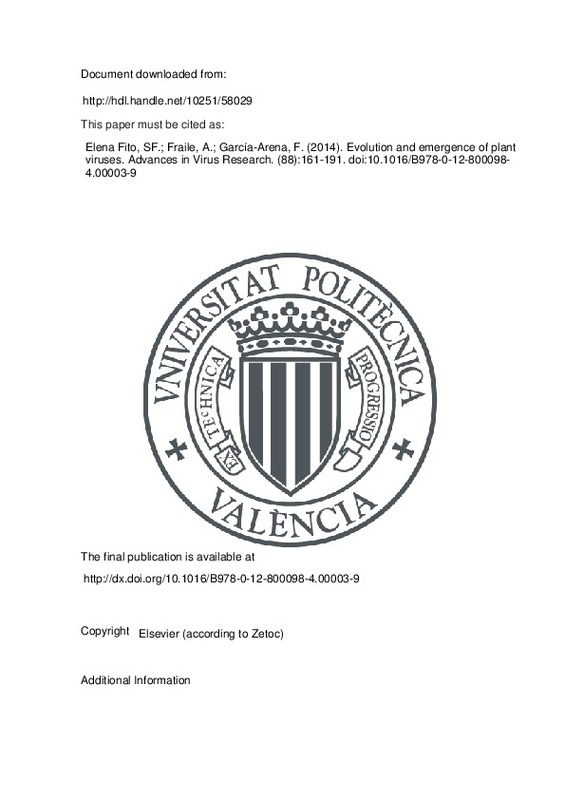JavaScript is disabled for your browser. Some features of this site may not work without it.
Buscar en RiuNet
Listar
Mi cuenta
Estadísticas
Ayuda RiuNet
Admin. UPV
Evolution and emergence of plant viruses
Mostrar el registro sencillo del ítem
Ficheros en el ítem
| dc.contributor.author | Elena Fito, Santiago Fco
|
es_ES |
| dc.contributor.author | Fraile, Aurora
|
es_ES |
| dc.contributor.author | García-Arena, Fernando
|
es_ES |
| dc.date.accessioned | 2015-11-24T14:37:01Z | |
| dc.date.available | 2015-11-24T14:37:01Z | |
| dc.date.issued | 2014 | |
| dc.identifier.isbn | 978-0-12-800098-4 | |
| dc.identifier.issn | 0065-3527 | |
| dc.identifier.uri | http://hdl.handle.net/10251/58029 | |
| dc.description.abstract | [EN] Viruses are common agents of plant infectious diseases. During last decades, worldwide agriculture production has been compromised by a series of epidemics caused by new viruses that spilled over from reservoir species or by new variants of classic viruses that show new pathogenic and epidemiological properties. Virus emergence has been generally associated with ecological change or with intensive agronomical practices. However, the complete picture is much more complex since the viral populations constantly evolve and adapt to their new hosts and vectors. This chapter puts emergence of plant viruses into the framework of evolutionary ecology, genetics, and epidemiology. We will stress that viral emergence begins with the stochastic transmission of preexisting genetic variants from the reservoir to the new host, whose fate depends on their fitness on each hosts, followed by adaptation to new hosts or vectors, and finalizes with an efficient epidemiological spread. | es_ES |
| dc.description.sponsorship | We acknowledge the financial support from the Spanish Dirección General de Investigación Científica y Técnica grants BFU2012-30805 (S. F. E.) and AGL2008-02458 (F. G. A.) | |
| dc.language | Inglés | es_ES |
| dc.publisher | Elsevier (according to Zetoc) | es_ES |
| dc.relation.ispartof | Advances in Virus Research | es_ES |
| dc.rights | Reconocimiento - No comercial - Sin obra derivada (by-nc-nd) | es_ES |
| dc.subject | Virus evolution | es_ES |
| dc.subject | Virus emergence | es_ES |
| dc.subject | Virus ecology | es_ES |
| dc.subject | Host adaptation | es_ES |
| dc.subject | Across-host trade-offs | es_ES |
| dc.subject | Antagonistic pleiotropy | es_ES |
| dc.subject | Epistasis | es_ES |
| dc.title | Evolution and emergence of plant viruses | es_ES |
| dc.type | Artículo | es_ES |
| dc.identifier.doi | 10.1016/B978-0-12-800098-4.00003-9 | |
| dc.relation.projectID | info:eu-repo/grantAgreement/MINECO//BFU2012-30805/ES/EVOLUTIONARY SYSTEMS VIROLOGY: EPISTASIS AND THE RUGGEDNESS OF ADAPTIVE LANDSCAPES, MUTATIONS IN REGULATORY SEQUENCES, AND THE HOST DETERMINANTS OF VIRAL FITNESS/ | es_ES |
| dc.rights.accessRights | Abierto | es_ES |
| dc.contributor.affiliation | Universitat Politècnica de València. Instituto Universitario Mixto de Biología Molecular y Celular de Plantas - Institut Universitari Mixt de Biologia Molecular i Cel·lular de Plantes | es_ES |
| dc.description.bibliographicCitation | Elena Fito, SF.; Fraile, A.; García-Arena, F. (2014). Evolution and emergence of plant viruses. Advances in Virus Research. (88):161-191. https://doi.org/10.1016/B978-0-12-800098-4.00003-9 | es_ES |
| dc.description.accrualMethod | S | es_ES |
| dc.relation.publisherversion | http://dx.doi.org/10.1016/B978-0-12-800098-4.00003-9 | es_ES |
| dc.description.upvformatpinicio | 161 | es_ES |
| dc.description.upvformatpfin | 191 | es_ES |
| dc.type.version | info:eu-repo/semantics/publishedVersion | es_ES |
| dc.description.issue | 88 | es_ES |
| dc.relation.senia | 266224 | es_ES |
| dc.identifier.pmid | 24373312 | |
| dc.contributor.funder | Ministerio de Economía y Competitividad |







![[Cerrado]](/themes/UPV/images/candado.png)

